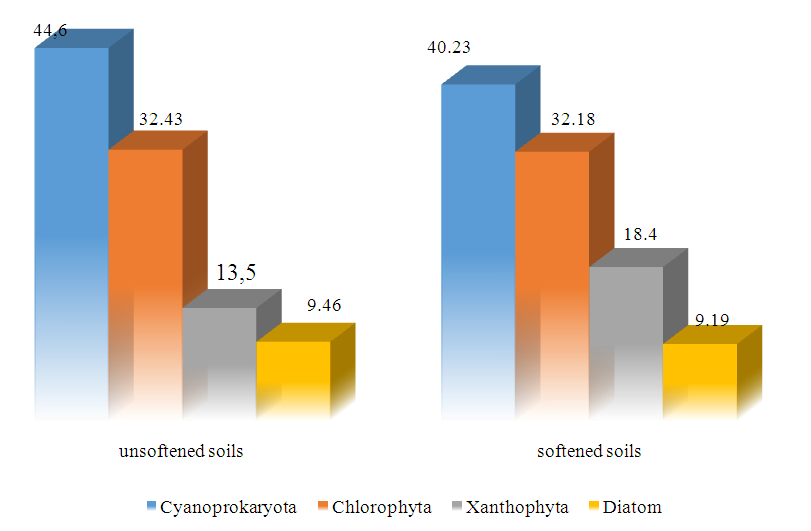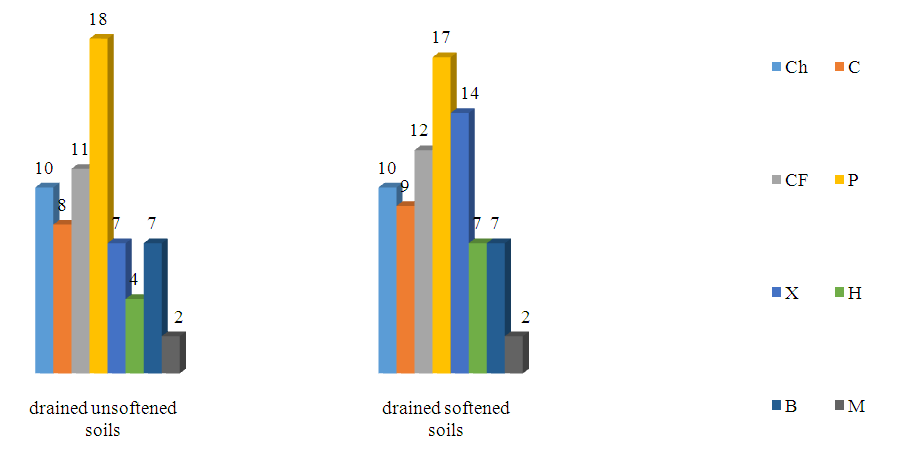-
Paper Information
- Paper Submission
-
Journal Information
- About This Journal
- Editorial Board
- Current Issue
- Archive
- Author Guidelines
- Contact Us
International Journal of Virology and Molecular Biology
p-ISSN: 2163-2219 e-ISSN: 2163-2227
2024; 13(3): 43-47
doi:10.5923/j.ijvmb.20241303.03
Received: Jun. 26, 2024; Accepted: Jul. 24, 2024; Published: Jul. 25, 2024

Development and Change of Soil Algae Flora in Fields
Tursunova Shakhodathan Abdujaborovna1, Mamasoliev Sardorbek Tursinovich2
1Kokan State Pedagogical Institute, Uzbekistan
2Andijan State University Doctor of Philosophy in Biological Sciences, Uzbekistan
Correspondence to: Tursunova Shakhodathan Abdujaborovna, Kokan State Pedagogical Institute, Uzbekistan.
| Email: |  |
Copyright © 2024 The Author(s). Published by Scientific & Academic Publishing.
This work is licensed under the Creative Commons Attribution International License (CC BY).
http://creativecommons.org/licenses/by/4.0/

The development of soil algae in the cultivated and uncultivated lands of the southwestern part of the Fergana valley, their conditions under different environmental conditions, and anthropogenic influences were analyzed. An analysis of soil algae distributed in the soils of wheat fields, alfalfa fields, vineyards, and orchards with cultivated areas was provided.
Keywords: Cultivated area, Soil algae, Species and species characteristics, Flora, Taxon
Cite this paper: Tursunova Shakhodathan Abdujaborovna, Mamasoliev Sardorbek Tursinovich, Development and Change of Soil Algae Flora in Fields, International Journal of Virology and Molecular Biology, Vol. 13 No. 3, 2024, pp. 43-47. doi: 10.5923/j.ijvmb.20241303.03.
1. Introduction
- Several significant global challenges, including population expansion, greenhouse gas emissions, and insufficient freshwater resources, have also impacted the agricultural sector. These issues lead to soil degradation, which in turn causes a decline in crop yields and an increase in plant diseases. It is of utmost scientific and practical importance to investigate the beneficial effects of soil algae on soil health and crop growth, as this represents a highly promising solution and to assess its potential for implementation. The scientific significance of the research results is that the species composition of cyanoprokaryotes and eukaryotic algae in the soil of the studied area was determined and fully inventoried. Seasonal changes of cyanoprokaryotes and eukaryotic algae taxa distributed in plowed layer, plowed layer in dryland wheat field, alfalfa field, cotton field, reserve land, orchard, vineyard soil are explained on a scientific basis. Based on the role of cyanoprokaryotes and eukaryotic algae in soils where syzotic algae have escaped. Research on soil algoflora worldwide is aimed at assessing agricultural land in different melioration states, the amount of rainwater in different states, seasonal changes in soil algae, and their effects on soil fertility. [1,8]
2. Materials and Methods
- The method of determining soil algae is divided into 3 stages:1) collection of soil samples;2) determining the taxonomic composition of soil algae;3) determining the amount of algae. [2,10]When collecting soil samples for algological research, generally accepted rules were followed: proper collection of samples, sterility, labeling and storage of samples, and procedures for studying the vegetation layer and soil. Vegetation, land area, agrotechnics, and soil characteristics of the locations chosen for sample collection were studied. All data were recorded in a field journal. During the research, the analysis of soil, microflora, and plants was performed at the same time that the sample was collected. During the study of the seasonal dynamics of algae, soil moisture, general appearance of the surface, level of moisture, and mechanical composition of the soil were considered. First, samples were taken from the surface part of the soil (0-2, 3 cm), and a "section" was prepared for sampling. First, the soil surface is examined. The presence of green, blue-green, or brown coverings and spots on the soil provides a visual quantitative assessment, particularly regarding the level of coverage. At the most typical location, the soil surface was collected with 1 cm thick algae. Soil surface samples were collected without damaging the surface covered with algae, and the integrity of the soil sample was preserved. The sizes of such samples were different, and the more the algae were mixed and evenly distributed, the smaller was the sample size. The samples were taken from an area of 10-50 cm2. The samples were placed in pre-sterilized special packages with the addition of the S horizon according to the genetic horizons. The sampling started from the upper horizon. The samples were dried. This did not affect the determination of the complete taxonomic composition of algae in it. [3,11]Strong paper, sealed envelopes, and bags were used as packing materials for the soil and algae samples. The packaging materials were sterilized before application in the field. The samples were placed in a cardboard box to avoid damage during long-distance transportation. The collection is labeled with the sample number, depth, horizon, and date of collection. [1,2]
3. Results and Discussion
- Cultivated soils are fundamentally different from uncultivated soils. When soils are plowed and cultivated, their biological properties, in particular, biogenicity and biological activity, increase. When soil is cultivated, the number of microorganisms increases, the importance of budding fungi decreases, and nitrification processes increase. [4,14]Tilling the soil in different ways leads to a change in the order of algal communities. Algae in tilled soils are dynamic; therefore, there are many similarities in the flora of algae in different geographical regions. To date, there is information in the literature about the effects of soil cultivation, including plowing, cultivation, fertilization, application of various insecticides, melioration, and even cultivation, on the composition and development of algae flora. This was first manifested in the composition of the algocinaria in each crop. According to data, the soil when wheat is planted in autumn has a richer algoflora than when it is planted in spring.Comparative data on the development of algae in protected and plowed soils were obtained from the Kursk region, Kharkiv, near Kiev, Siberian soils, Azerbaijan, Western Pamir soils, and Baashkirdstan. Softening by mechanical tillage does not stop the development of algae, and their redistribution has a positive effect on the number of species in the plowed layer and on the development of their cells. Reduced activity at the soil surface. After plowing the soil, its surface first developed phototrophic greens, followed by yellow-green greens and cyanobacteria. If climatic conditions are favorable and light, moisture, and nutrients are sufficient, the initial order of algae will be restored within a few weeks. This situation depends on the soil composition and number of hydrothermal conditions. Deep plowing of the land leads to enrichment of the lower layer with algae. Microbiological and enzymatic activities were increased. Mechanical soil processing changes agrophysical properties. This, in turn, accelerates biological and chemical processes. The roots of the plants were wider and deeper, and the amount of humus increased. Increasing the biological activity of the soil leads to an increase in crop productivity. Biological activity is related to soil moisture, which is important in arid regions. [5,10]The flora of soil algae change depending on the development of separate groups of organic and mineral fertilizers. Algae in the soil are highly sensitive to mineral fertilizers under conditions of sufficient moisture. According to the data, the long-term application of fertilizers to the soil leads to an increase in the species of algae. The application of large doses causes changes in the composition of dominant species and stops the development of individual species. High doses of fertilizers reduce the number of algae and reach the physiological plasmolytic stage. All nitrogen fertilizers had a positive effect on the development of algae and increased the number of cells. Cyanobacteria react negatively to high doses of nitrogen and phosphorus fertilizers. Green and yellow-green ubiquitous algae have been proposed as indicators of soil nutrient availability. It has been determined that the effect of herbicides on algae is non-toxic, depends on the type of soil, its moisture, and the time of application. Herbicides exert inhibitory or stimulatory effects on different groups of algae at certain concentrations. Soil drying affects the number of algal species. An increase in the soil moisture leads to algal growth. The number of water-loving species has also increased in recent years. During irrigation, aquatic or amphibious species enter the soil through water. After drying the soil, the algae in it were studied in peat layers. The living conditions of the microorganisms in it improved, and the biogenicity and biological activity of the soil increased. [6,9]It has been determined that the composition of algae in peat deposits in the Kirov region depends on the degree of change in its water regime and its vegetation cover. The biological diversity of the species belonging to the Cyanobacteria, Chlorophyta, and Xanthophyta divisions increased. When peat dries, new algal flora is formed. The biological activity of peat increased by the third year of use, with 25-35 thousand cells in 12 peat samples, and its biomass reached 170-240 kg/ha. Changes in algoflora due to the reclamation of Karelian peats include hydrophilic, epiphytic, and soil groups. Edaphophilic species comprised 50% of the species encountered and the dominant list consisted of hydrophilic amphibian species. Peat soils are defined as: 1) species present in peat and 2) from other biotopes. The number of edophilic species increases by up to 75% in dried soils. Soil softening is considered to be a way to effectively improve its physical properties. Digging drainage ditches, deep loosening of the soil, and application of mineral fertilizers improved the activity of microorganisms and plant roots, and the soil structure became more active. As a result, the soil fertility increased. Ammonifiers, nitrophilizers, and cellulose-decomposing aerobic microorganisms increase by 2-8 times in the softened layer. Increased biological activity leads to an increased yield of winter wheat in softened soils. Based on the data, deep reclamation had a positive effect on the activity of micro- and mesofauna in the soils of the Moscow Region. Simple animals and earthworms decrease in softened, dried soils. [7,8]Thus, it can be concluded from the given data that under the conditions of Russia, drying and deep meliorative softening improve the unfavorable water-physical characteristics of heavy soils and change the direction of biological processes. In our arid region, soil moisture is low, the activity of organisms, including algae, is low, and a description of the general algoflora based on indicators of their species composition and number of cells has not been carried out until now. As a result of the research based on the methods used, 190 species were identified from the composition of the cultivated areas, which were grouped into 4 sections, 9 classes, 10 orders, 27 families, and 64 genera. The distribution of the algogroups by section, class, order, family, and category is presented in Table (Table 1).
|
|
 | Figure 1. Stationary soil algoflora (in percent) |
 | Figure 2. Interrelationships of life forms of soil algae |
4. Conclusions
- Thus, the increase in the number of cotton field algae species in summer was mainly due to diatom algae. In autumn samples, dominance was transferred to a section of cyanobacteria (36.7%). Biodiversity in alfalfa field soils was 37% in winter. A low percentage (22%) occurred in the autumn. Green algae were abundant in spring (37%); in other seasons, they consisted of the same number of species. Species of diatom algae were abundant in summer -46.4%. Yellow-green plants are characteristic of cotton fields, and the number of species is high in paddy fields. Biodiversity of algae in alfalfa field soils corresponds to summer. The increase in the number of species continued from winter to the end of summer, and then decreased again in autumn. The number of algal species varied in the same way in wheat field soils and uncultivated reserve soils. The biodiversity of the species was higher in the winter and lower in the summer. The number of algal species was the same in spring and autumn. [3,11]
 Abstract
Abstract Reference
Reference Full-Text PDF
Full-Text PDF Full-text HTML
Full-text HTML
